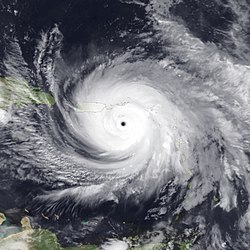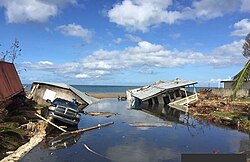
The 2017 Puerto Rico hurricane season was a hurricane season in which the Caribbean island of Puerto Rico, an unincorporated territory of the United States since 1898, was particularly badly hit. The worst element of this was Hurricane Maria. This struck the island between the 19th and the 21st of September 2017 and was the worst storm to hit the island in nearly 90 years. The official death toll from Hurricane Maria on Puerto Rico was 2,975 people. It also caused around $90 billion dollars’ worth of economic damage and led to a humanitarian crisis, with hundreds of thousands of the island’s 3.3 million residents being displaced. The 2017 hurricane season exacerbated an already very tangible migration and depopulation crisis on Puerto Rico, a country where the population had been nearing four million as recently as the early 2000s, but which declined close to three million in the aftermath of Hurricane Maria. Many of those who left Puerto Rico headed to the United States, with 120,000 alone leaving Puerto Rico in the months after the hurricane.[1]
2017 Puerto Rico hurricane season chronology of events
When it comes to hurricanes worldwide, the Pacific Northwest is actually the part of the world which experiences the most extreme weather events of this kind on average every year. We rarely hear about this though for the very simple reason that places like the Kamchatka Peninsula are not exactly densely populated. Instead the Caribbean, the Gulf of Mexico and the south-eastern United States are the regions of the world where we most often read news headlines about hurricane seasons. 15% of the world’s tropical cyclones occur here and they often strike violently at densely populated coastal communities. 2017 was a particularly intense year and Puerto Rico, an unincorporated territory of the United States since the Spanish-American War of 1898, was the epicenter of hurricane activity in the Caribbean that year.[2]

Numerous storms hit Puerto Rico during hurricane season that year, which usually takes place in the late summer and through the autumn. On a normal year, Hurricane Irma, which came through the Caribbean in the first weeks of September 2017, would have been considered a particularly brutal storm, one which was a Category 5 hurricane and inflicted $77 billion dollars’ worth of damage in a wide swathe territory between the Leeward Islands and Florida. It also led to the deaths of around 134 people in all across a substantial geographical territory. However, it had weakened substantially by the time it reached Puerto Rico to a Category 4 storm and did not cause immense damage there.[3]
In any event, Irma was soon completely overshadowed by Hurricane Maria. Maria was a Category 5 hurricane which came through the Caribbean just over a week after Irma. It was at its most intense as it swept over Puerto Rico between the 19th and the 21st of September 2017, making landfall on the 20th as a high-end Category 4 storm. Entire villages and neighborhoods were leveled to the ground by gusts of wind that roared through at over 150 miles per hour in some instances.[4] As happens with any such storm, the wind itself did not lead to major fatalities, but rather the debris which it loosened and turned into airborne missiles, flooding and other knock-on effects did. Around $90 billion dollars’ worth of damage was inflicted on the physical infrastructure and economy of Puerto Rico in what was most likely the worst storm seen since the 1930s.[5]
While the exact death toll is always hard to gauge when it comes to natural disasters like this, over 2,950 people were killed at least and the official figure is usually given as 2,975 today. However, the death toll issue has been a source of major controversy, with the government initially completely understating the figure as being just a few hundred people owing to poor reporting practices. Others maintain today that the figure may be as high as 8,000 when excess deaths related to the storm are taken into account such as interruptions to health care services which resulted in premature death late in 2017 and into 2018.[6]
Extent of migration after Hurricane Maria
Hurricane Maria left hundreds of thousands of Puerto Ricans displaced, their homes destroyed along with their livelihoods. In the months that followed approximately 120,000 Puerto Ricans decided to leave their island home. Nearly all of these migrated to the United States, a region where Puerto Ricans have rights of entry owing to Puerto Ricans being considered citizens of the US, although Puerto Rico is a territory rather than a state. More broadly, the 2017 storm season has contributed to the continuing depopulation of Puerto Rico, something which some demographers contend will see the population fall to below two and a half million people by 2050.[7]
Demographic impact of Hurricane Maria

The most notable demographic impact of the 2017 Puerto Rican hurricane season was a further decline in the population of Puerto Rico, which was already experiencing a steady downward trajectory since about 2003. The population fell to slightly under 3.3 million people in the aftermath of Maria and has largely flat-lined ever since.[8] On the other side, the demographic impact of Puerto Rican emigration following the 2017 storm season has been felt most keenly in the United States. We tend to associate Puerto Rico immigration to the US with the Nuyorican community (a portmanteau of New York and Puerto Rican), but in actuality the states in the US that have experienced the greatest surge in Puerto Rican settlement in modern times, the aftermath of Maria included, are Florida, Connecticut and Rhode Island. As of 2022, people of Puerto Rican heritage make up 8% of the population of the state of Connecticut.[9]
See also
Explore more about the 2017 Puerto Rico Hurricane Season
- 2017 Hurricane Maria at Worldvision
- A Timeline of Hurricane Maria at The Atlantic
- Puerto Rican Research at Legacy Family Tree Webinars
References
- ↑ https://www.mercycorps.org/en-gb/blog/facts-hurricane-maria-puerto-rico
- ↑ https://ocean.si.edu/planet-ocean/waves-storms-tsunamis/hurricanes-typhoons-and-cyclones
- ↑ https://www.worldvision.org/disaster-relief-news-stories/2017-hurricane-irma-facts
- ↑ https://www.mercycorps.org/en-gb/blog/facts-hurricane-maria-puerto-rico
- ↑ https://time.com/a-land-they-no-longer-recognize/
- ↑ https://www.hsph.harvard.edu/news/features/hurricane-maria-deaths/
- ↑ https://hemisphericinstitute.org/en/emisferica-14-1-expulsion/14-1-essays/the-emptying-island-puerto-rican-expulsion-in-post-maria-time.html
- ↑ https://www.macrotrends.net/global-metrics/countries/PRI/puerto-rico/population#google_vignette
- ↑ https://puerto-rican-studies-initiative.clas.uconn.edu/2021-profile-of-puerto-ricans-in-connecticut/